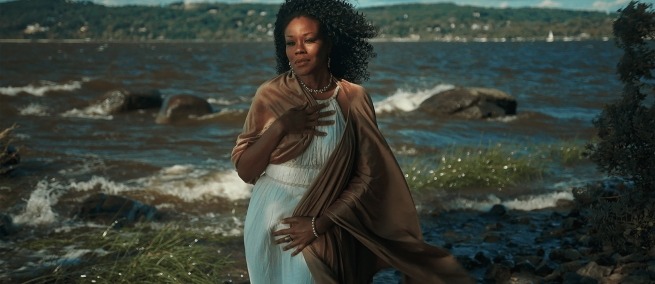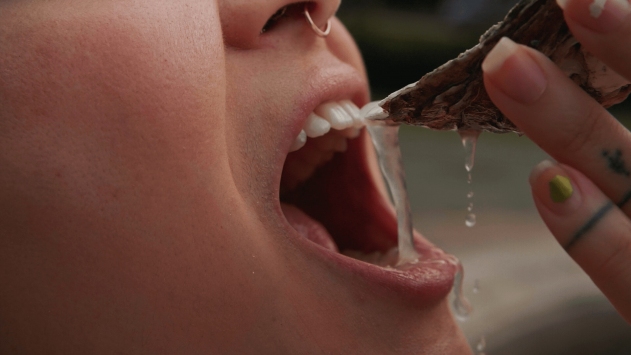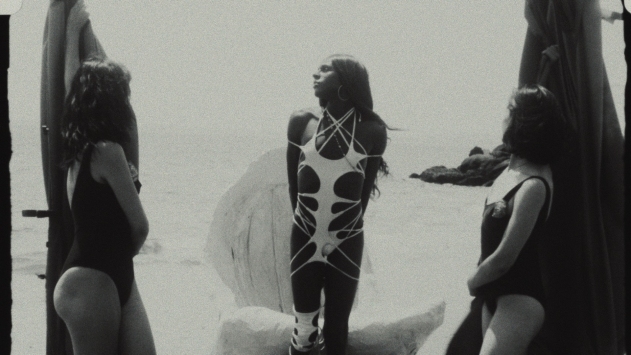
HOLDING BACK THE TIDE, a new feature documentary based in New York City, urges viewers to “reconsider the oyster.” Director Emily Packer blends techniques to tell the story of the oyster from multiple perspectives, including its function in the past, present, and future of the city, its ability to self-fertilize—shifting from male and female during its life cycle, and its social impact. The film made its world premiere at DOC NYC in 2023, and is being released into the theaters by Grasshopper Film. It will open on September 6 at DCTV’s Firehouse Cinema, followed by LA’s Laemmle Theatres beginning October 4. We spoke with Packer about her approach the subject and collaborators.
Science & Film: Could you speak a bit about working in different modalities in the making of this film–scripted, archival, documentary–and why that made sense to you for this story?
Emily Packer: The longer I've been in documentary, the less I feel tethered to a specific mode of storytelling. The more I see the puppet strings that go into documentary storytelling, the more I feel ready to break form. There seems to be more of a palette for it these days, everything from the Ross Brothers doing documentary that's very scripted, to like, I don't know. I just think that if we as doc filmmakers are being more honest about our process, there's so much more possibility. And I think sometimes being over the top, or even a little campy about it, that feels more honest to me.
There were things that we decided were really important to the lens that we were seeing the oyster with and were informing our new understanding of the oyster. Those were things that we couldn't necessarily overhear, and so that created an invitation for us to break outside of the box. We tried to treat each theme with its own set of rules. We would find a lot of crossover between things that we had shot in the verité, and things that we wanted to do, that we had scripted out, and that also sort of allowed us to figure out what was the story, and what was maybe overkill, or what was going to blend these ideas together.
At the start of the project, I think that I pitched this to my team as a short, straightforward enviro doc that was just going to talk about the journey of the oyster shell as a cyclical cycle, as opposed to a linear one. And then shortly after pitching that idea and starting our research, we saw a short documentary that did exactly that. There was a small amount of disappointment in finding that out, but it was also relieving, because we were like, great, we don't have to make that, someone else made that. We get to do something else now and if someone wants to see that movie, it already exists.

An extreme close up of an oyster dripping succulent juices into an open mouth. Photo by Ben Stil. Pictured: Avery Osajima.
S&F: What drew you to oysters to begin with?
EP: I had been doing research about New York's waterways for a short film that I made with Lesley Steele called BY WAY OF CANARSIE. We had been prompted by a fellowship with Union Docs to be looking into transit. And so, we were thinking about resources a lot, and we were thinking about the water a lot. Lesley and I both feel very spiritually drawn to the water, and I almost feel more honest about that spiritualism because of working with her. We started looking into a potential ferry that some folks in the community wanted in Canarsie, Brooklyn. We were thinking, if this ferry is to happen, what will change? What will change about the community that exists here already? What will change about the underwater ecosystem? It was around that time that I learned about the Billion Oyster Project whose goal is to plant one billion oysters into the New York Harbor. I was really caught up by that billion number. It felt sort of arbitrary to me in some ways. What will happen if they hit a billion? Why is that the goal? I also starting to think about, like, what we as the city are willing to invest in our future. And so, while we were watching tons of resources being poured into, honestly, a not very well thought out plan to rehabilitate the L train after Hurricane Sandy, and also thinking about billions of resources being pushed into the water a little oyster at a time... In some ways that was really what interested me about the oyster. It was not just it as a creature or it as a food or anything, but it as this emblem for New Yorkers and for the idea of a collective project.
S&F: I saw in the credits you had an environmental consultant. I'm curious who that person was, why that felt important to you, and how you navigated working with experts in the field with this project?
EP: We interacted with a number of experts, but we ended up calling a few folks consultants, including the more environmentalist consultant Kate Boicourt. When I met her, she was working at the Waterfront Alliance, which is a large-scale organization that I feel really connected to the mission of, about access to the waterfronts. It's sort of an umbrella organization that ties together a lot of different things happening throughout the city. And so, she and I felt aligned in our understanding of New York. And then she ended up working for the Environmental Defense Fund. We shared cuts [of the film] with her. I talked to her about how important it is to for the audience to understand the specifics of the science when it comes to, like, the biological reproductive cycle of the oysters, and also the question: How wide is the scope of the science that we're covering? And the difference between an audience's understanding when they get out of the film, but also our understanding as we're making the thing. There are some facts and larger-scale understandings that have totally led to why we're doing things a certain way, but they are not necessarily going to be translatable to the audience. And so picking and choosing what is actually important for the audience to walk away knowing. Some of that was determined by our themes, and some of it was determined by those conversations with her. The film was much more stylistic than Kate had prepared for, and we have gotten to talking about educational asides that we might make. But overall, I think she was really instrumental in making sure that we took all [those questions] into consideration.
We also had a poetic consultant or two, which was really fun. One of them has an MA in poetry and both of them are trans. We wanted to also throw that expertise in the mix of, like, how are we using language? What does it mean for us to write a water acknowledgement that comes back into the piece? One of the biggest things that their consultancy created for me was a different way of understanding the language from the beginning of the film to the end of the film. What is the actual transformation?
And then we had some more sociological consultants, who were folks who were studying the oyster as a historical device in Long Island specifically. It was really great to chat with those two people who know so much about it and got to recommend different places that we do research or for us to film. We could only learn so much in four years of doing research about this but being able to tap into different knowledge was super helpful.

A young Black trans woman emerges from a shell in a queer recreation of the early film “Birth of a Pearl” (1901, Armitage). Photo by Lucas C. Ospina. Pictured (L to R): Meagan Dolbey, Aasia Taylor-Patterson, Emily Packer.
S&F: Were there aspects of the history or science of the oyster that you came across in your research that you were surprised hadn't been surfaced before?
EP: Definitely. There are even things that we didn't feel we could cover adequately, that I sometimes wish had been able to be a part of the film. But I think for who our team was and the time that we were making it, which was mostly during COVID, the scope of it that we were able to cover turned out to be very personal to us. But there are so many more stories. There's all this history with the Sandy Ground Historical Society, which is about the community of freed black oyster men who came up from the Carolinas to create one of the first free communities, and they built their whole infrastructure off of the oysters and their knowledge of oystering. I would have loved to do more with that story but, unfortunately, because the main keepers of that knowledge were rebuilding their organization after Hurricane Ida... All of the crossover was so plain to me, of how environmental crises are affecting different communities differently, and this was just something that we couldn't pursue. I honestly think that there's more to be told, and there's more to be told by different filmmakers.
S&F: Now that the film is coming out, do you have any hopes for the takeaways people might have from it?
EP: I've been thinking a lot about something that I've called avenues of access, or different audiences getting a different read on the film depending on what knowledge they have. In test screenings, I've been very relieved and very happy with how different folks interact with that information. For example, I did a small screening with mostly queer and trans community members out of Santa Cruz in April. It was really wonderful because this was the first audience where, once the lights came up, everyone could talk about it as a queer movie and as a trans movie, and that audience got what I wanted out of framing the queer gaze on the oyster and utilizing that as sort of a film theory praxis. They had new and better interpretations of some of the narrative that I had not even thought of, and that was really affirming. I hope for more of that.
I also, you know, I do hope that, although it's not an activist film, I do hope that it helps to recreate the narrative for the oyster in New York City, such that the environmental groups that are doing the work can be better bolstered. One of the organizations that we have in the film is the SCAPE landscape architecture firm and Pippa Brashear, who we interviewed, is really clear about the fact that, in order for their work to happen, in order for it to be publicly supported, we have to change the story of what the oyster has been in New York. I think that this reframing is the best thing I could hope for. It's not just seeing this creature as absolutely vital to the ecosystem that is going to support New York into the future as a natural space and a city space, but people also remember that this food is living, that this creature that is so necessary for our survival is trans and has this incredible capability of change. The hope is that we start to see less of an anomaly in that transness and more of a huge, powerful tool that can also be understood as sort of humanist.
♦
TOPICS